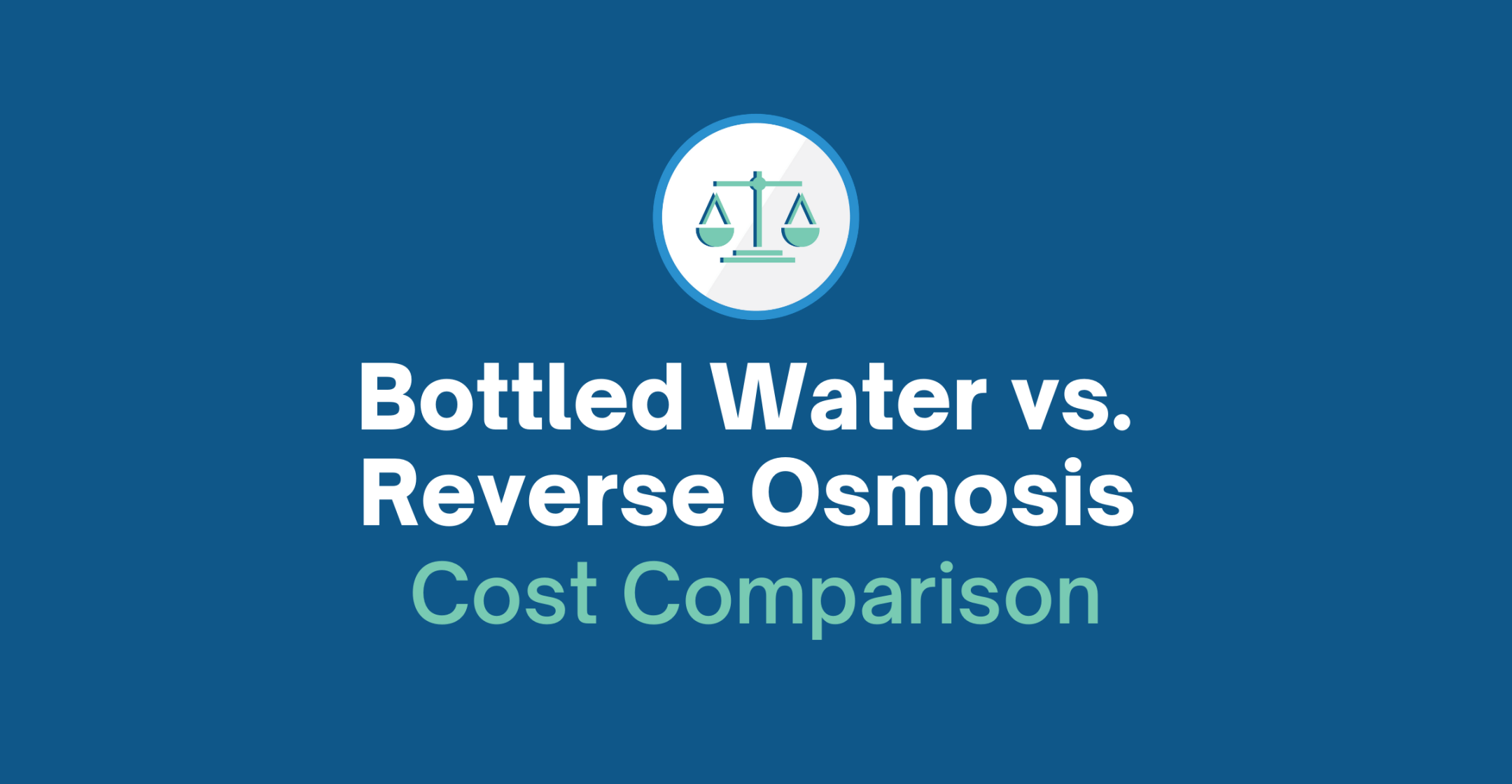Cost Comparison: Bottled Water vs. Reverse Osmosis

Drinking Water
If you are like many other Americans, the thought of drinking and cooking with water straight from the tap is not incredibly attractive. If that is the case, you may have subjected yourself into the habit of buying bottled water as a solution to this problem.
While buying bottled water at its cheap price may seem like the economical choice at first glance, you may be surprised at what you learn in this post. A complete drinking water purification system for your home can make sense not only for you and your family’s health, but also for your pocketbook.
Purified or Not?
The first question to ask, “is purified drinking water important?” is one that certainly needs to be addressed before diving into the cost comparison of bottled water vs. Reverse Osmosis.
The water that comes from a city water or well water source can still be full of contaminants that are unhealthy for human consumption. Thoroughly purifying the water that will be consumed a good way to promote a healthy lifestyle.
How Much Water Do We Consume?
You probably consume more water than you might think. Water is consumed not only when you drink a glass of water. Drinking water is used when cooking, drinking beverages with ice, coffee, tea, and other water-based beverages.
I am sure that you, at some point in your life, have heard that everyone needs to drink eight 8-ounce glasses of water every day to stay hydrated. While this would be very good for business, there hasn’t actually ever been a study that indicated this. But here is what we do know.
The Institute of Medicine of the National Academies released an in-depth study by the Food and Nutrition Board that covered the intake of water, titled, “Dietary Reference Intakes for Water, Potassium, Sodium, Chloride, and Sulfate”
This was an incredibly intense study, almost 650-pages long. The findings were rather interesting on water intake.
- The vast majority of healthy people adequately meet their daily hydration needs by letting thirst be their guide. General recommendations for women at approximately 2.7 liters (91 ounces) of total water — from all beverages and foods — each day, and men an average of approximately 3.7 liters (125 ounces daily) of total water.
- About 80 percent of people’s total water intake comes from drinking water and beverages — including caffeinated beverages — and the other 20 percent is derived from food.
Did you catch that? The general recommendation for all water intake (including water, beverages, and food) is 91 ounces per day for women, and about 125 ounces per day for men.
Of those 91 and 125 ounces, approximately 80% is consumed from drinking water and beverages, such as coffee – while the remaining 20% is from food.
Parameters for Consumption
Our cost analysis will be based on the following example:
Household A will be comprised of a family of 5, two adults (male and female) and three children.
For the adults, the fluid intake stated above will be used as the parameter, 1 gallon per day for men, and ¾ gallon per day for women., and for the children we will use 1/3rd gallon per day.
To account for extra consumption that might take place such as for ice, cooking, visitors, pets water bowl, etc, ½ gallon per day will be added to each household.
Parameters for Cost
Our cost analysis will be based on an average gallon of bottled water cost and a standard reverse osmosis system.
At your local grocery store, you can probably purchase a gallon of water for anywhere from $0.85 to $1.09. This analysis will use $0.95/gallon as our cost number for bottled water.
Reverse osmosis systems can vary, but in general there will be an initial investment, and then an annual service cost. The standard Reverse Osmosis system will be set at $1,100 for the initial investment, and then $260 for annual service.
Results
Household A: (Consumption: 3 ¼ gallons of purified water per day)
- Bottled Water Cost (1 year) at $0.95/gallon: $1127
- Bottled Water Cost (5 years) at $0.95/gallon: $5,635
- Standard Reverse Osmosis (1 Year – includes purchase & maintenance): $1,100
- Standard Reverse Osmosis (5 Years – includes purchase & maintenance): $2,140
A Few Things to Keep In Mind About the Results
- This doesn’t consider the cost/time of driving to the store to pick up water or have it delivered.
- Reverse Osmosis systems provide an unlimited amount of water. So even though these calculations were based on certain water consumption rates, another benefit to the reverse osmosis is unlimited water on tap.
- The reverse osmosis system can also be easily connected to your ice machine or freezer, ensuring purified ice, free of chemicals that can spoil the flavors of your beverage.
- An RO system that is installed in your home should be looked at as an asset. It adds to the value of your home. So even the initial investment of the system should be easier to swallow because of this
Reverse Osmosis vs. Bottled Water
Despite that this article has consisted entirely of comparing bottled water to reverse osmosis, the two are not the same. Bottled water is oftentimes not purified to the extent that reverse osmosis is, and even if it is, it sits in the plastic water bottled for weeks, if not months, before being used. Reverse osmosis, on the other hand, purifies the water on demand, fresh and ready.
Bottled water also brings a host of troubles when it comes to microplastics. Numerous studies have shown that all the “big brands” in the bottled water industry continue to test positive for microplastics.
Quality: We wrote an article that looks in-depth at the quality of bottled water. There have been multiple studies done that point to the fact that bottled water is not the high-purity water that so many of us believe. Much of bottled water is simply municipal water put into a bottle with nearly no filtration at all! A recent study found micro-plastics in many popular bottled water brands. On average, they found twice as many micro-plastics in bottled water as are found in municipal water.
Single-Use Plastics: Another major negative regarding bottled water is the amount of plastic used in the process. Most bottled water is designed to be single-use and disposable. Many brands make recyclable bottled water, but unfortunately, only about 34% of the waste from the U.S. is recycled.
Final Thoughts
When you see that reverse osmosis wins in water quality compared to bottled water, it wins in sustainability through not using single-use plastics compared to bottled water, and it costs significantly less than bottled water – The choice is clear.
Ready to Take Control of Your Water Supply?
Don’t wait for water shortages or unreliable sources to disrupt your life. With our Rainwater Harvesting systems, you can enjoy a sustainable, reliable, and completely self-sufficient water solution tailored to your home’s needs.

